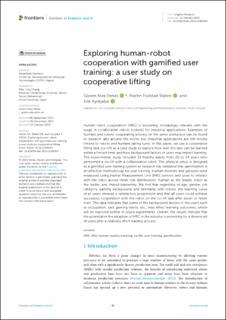| dc.contributor.author | Venås, Gizem Ates | |
| dc.contributor.author | Stølen, Martin Fodstad | |
| dc.contributor.author | Kyrkjebø, Erik | |
| dc.date.accessioned | 2024-02-05T11:23:29Z | |
| dc.date.available | 2024-02-05T11:23:29Z | |
| dc.date.created | 2024-01-23T08:48:53Z | |
| dc.date.issued | 2024 | |
| dc.identifier.issn | 2296-9144 | |
| dc.identifier.uri | https://hdl.handle.net/11250/3115558 | |
| dc.description.abstract | Human-robot cooperation (HRC) is becoming increasingly relevant with the surge in collaborative robots (cobots) for industrial applications. Examples of humans and robots cooperating actively on the same workpiece can be found in research labs around the world, but industrial applications are still mostly limited to robots and humans taking turns. In this paper, we use a cooperative lifting task (co-lift) as a case study to explore how well this task can be learned within a limited time, and how background factors of users may impact learning. The experimental study included 32 healthy adults from 20 to 54 years who performed a co-lift with a collaborative robot. The physical setup is designed as a gamified user training system as research has validated that gamification is an effective methodology for user training. Human motions and gestures were measured using Inertial Measurement Unit (IMU) sensors and used to interact with the robot across three role distributions: human as the leader, robot as the leader, and shared leadership. We find that regardless of age, gender, job category, gaming background, and familiarity with robots, the learning curve of all users showed a satisfactory progression and that all users could achieve successful cooperation with the robot on the co-lift task after seven or fewer trials. The data indicates that some of the background factors of the users such as occupation, past gaming habits, etc., may affect learning outcomes, which will be explored further in future experiments. Overall, the results indicate that the potential of the adoption of HRC in the industry is promising for a diverse set of users after a relatively short training process. | en_US |
| dc.language.iso | eng | en_US |
| dc.publisher | Frontiers | en_US |
| dc.rights | Navngivelse 4.0 Internasjonal | * |
| dc.rights.uri | http://creativecommons.org/licenses/by/4.0/deed.no | * |
| dc.subject | Human-Robot Interaction | en_US |
| dc.subject | Human-Robot Interaction | en_US |
| dc.subject | Treghetsnavigasjon | en_US |
| dc.subject | Inertial Navigation Systems | en_US |
| dc.title | Exploring human-robot cooperation with gamified user training: a user study on cooperative lifting | en_US |
| dc.type | Peer reviewed | en_US |
| dc.type | Journal article | en_US |
| dc.description.version | publishedVersion | en_US |
| dc.rights.holder | © 2024 Venås, Stølen and Kyrkjebø | en_US |
| dc.source.pagenumber | 20 | en_US |
| dc.source.volume | 10 | en_US |
| dc.source.journal | Frontiers in Robotics and AI | en_US |
| dc.identifier.doi | 10.3389/frobt.2023.1290104 | |
| dc.identifier.cristin | 2232628 | |
| dc.source.articlenumber | 1290104 | en_US |
| cristin.ispublished | true | |
| cristin.fulltext | original | |
| cristin.qualitycode | 1 | |

